Helen DeRam has an eye for visual storytelling, often communicating layers of meaning with her photo and product choices. It’s no surprise we love having her as part of the team and today she’s back on the show to chat about photography from a passionate amateur’s perspective. We touch on how she brings detail and perspective into her images as well as the truth behind taking selfies for scrapbooks and social media. Helen also wanted to share these tips and examples:
Better Photos for Scrapbooking
All of these photos were taken using the camera on my phone. Either by holding it out or using the timer. These are mostly as-hot, cropped only to fit the format for this post.
01 – Selfies
Example of multiple shots, take a bunch at once. Hold the camera out, move your head, then move the camera, use your other hand to take the photo.
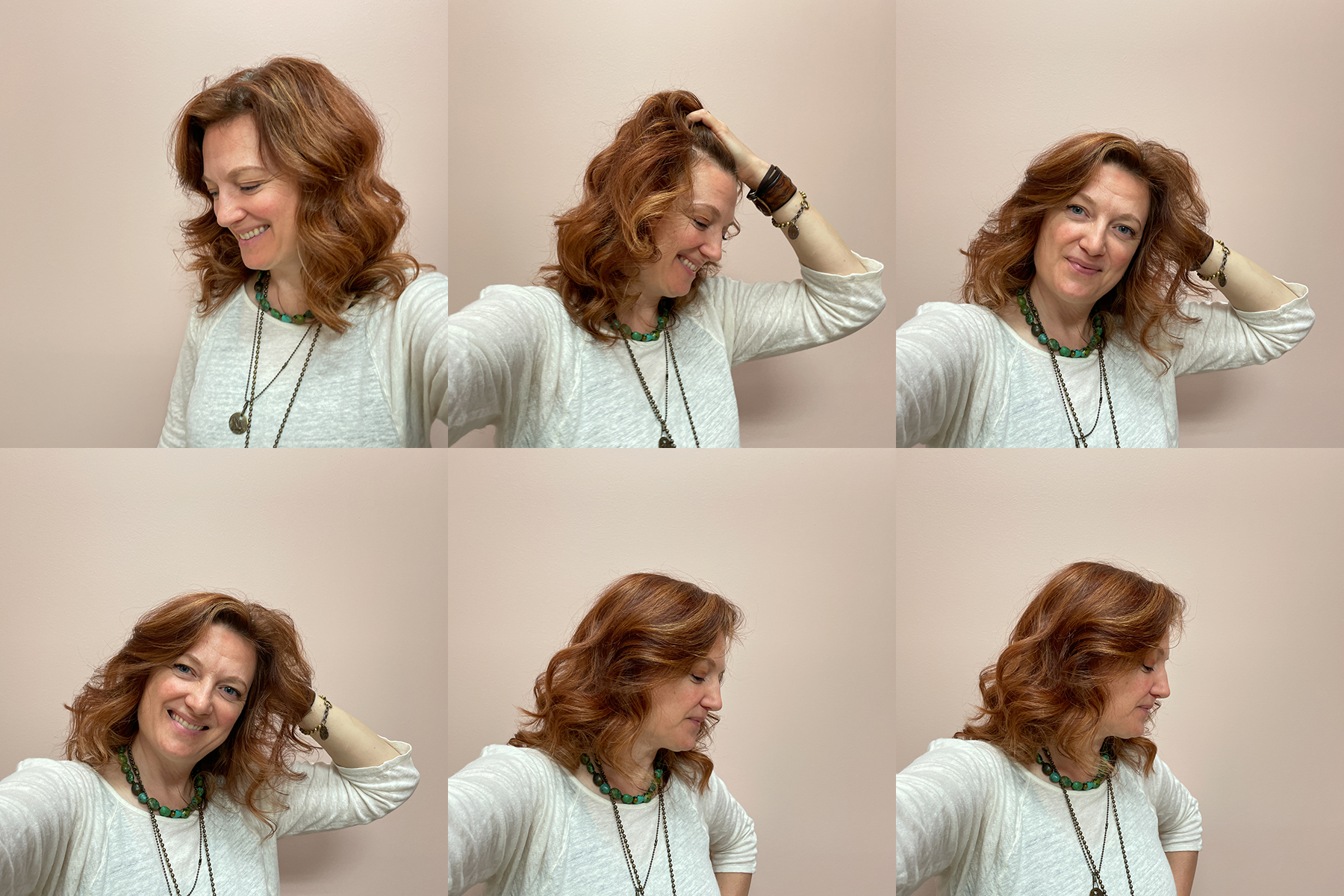
02 – More Selfies
Then take some more. Change the format, try both vertical and horizontal. The final photo in this series was the one I used for Instagram and it’s a cropped version of the one next to it. No need to see that my selfie was taken in the bathroom at work.
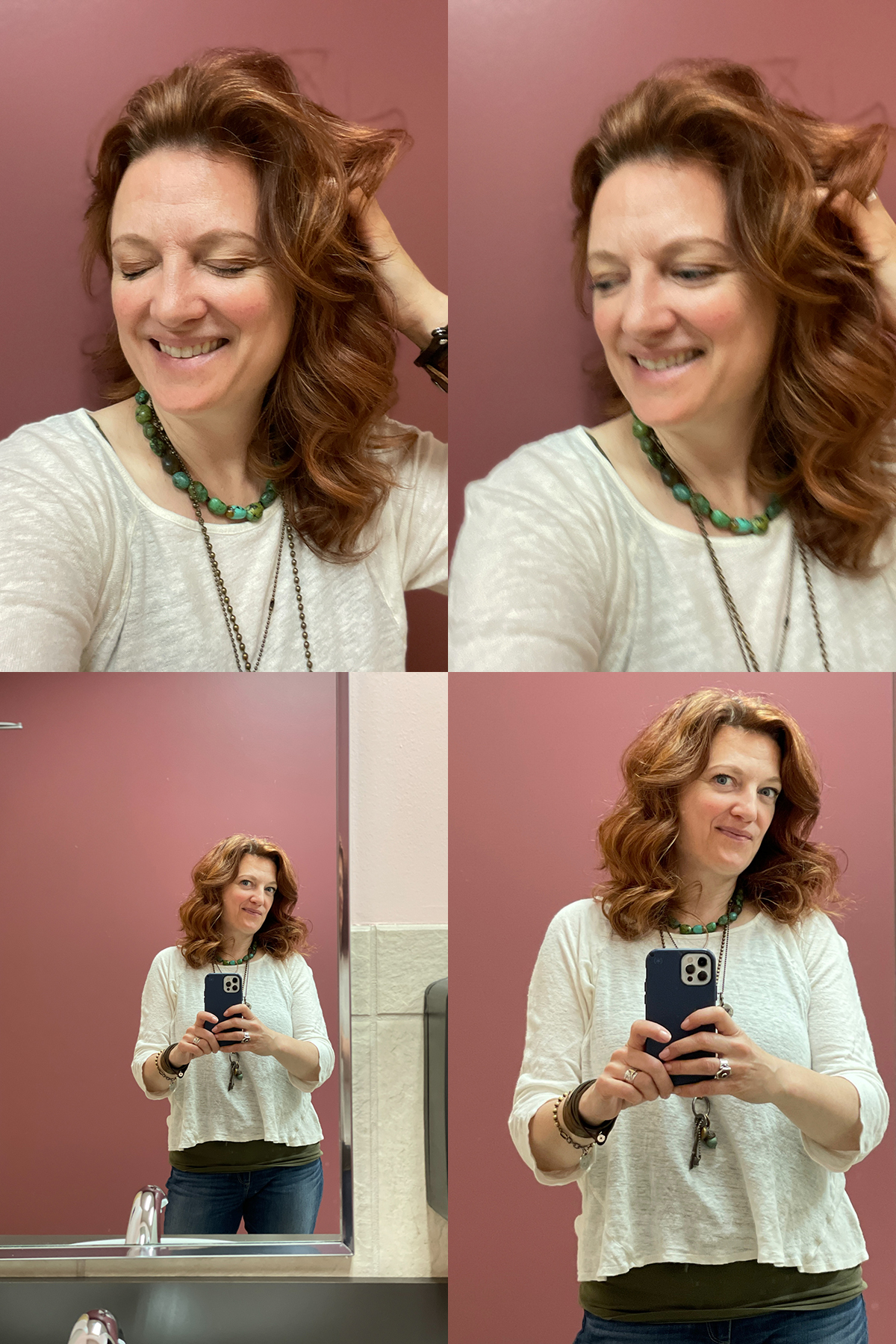
03 – Zoom In
Don’t be afraid to zoom in or cut off. In these photos I wanted to show the flower in my pocket and my new necklace.

04 – Timer
Use your timer to capture a moment or the things you love to do. I spend a lot of time gardening and I take lots of photos of the garden, but I want to capture the work I put into it. I often take photos of my cat, doing cute cat things but I want to make sure to capture our interactions.
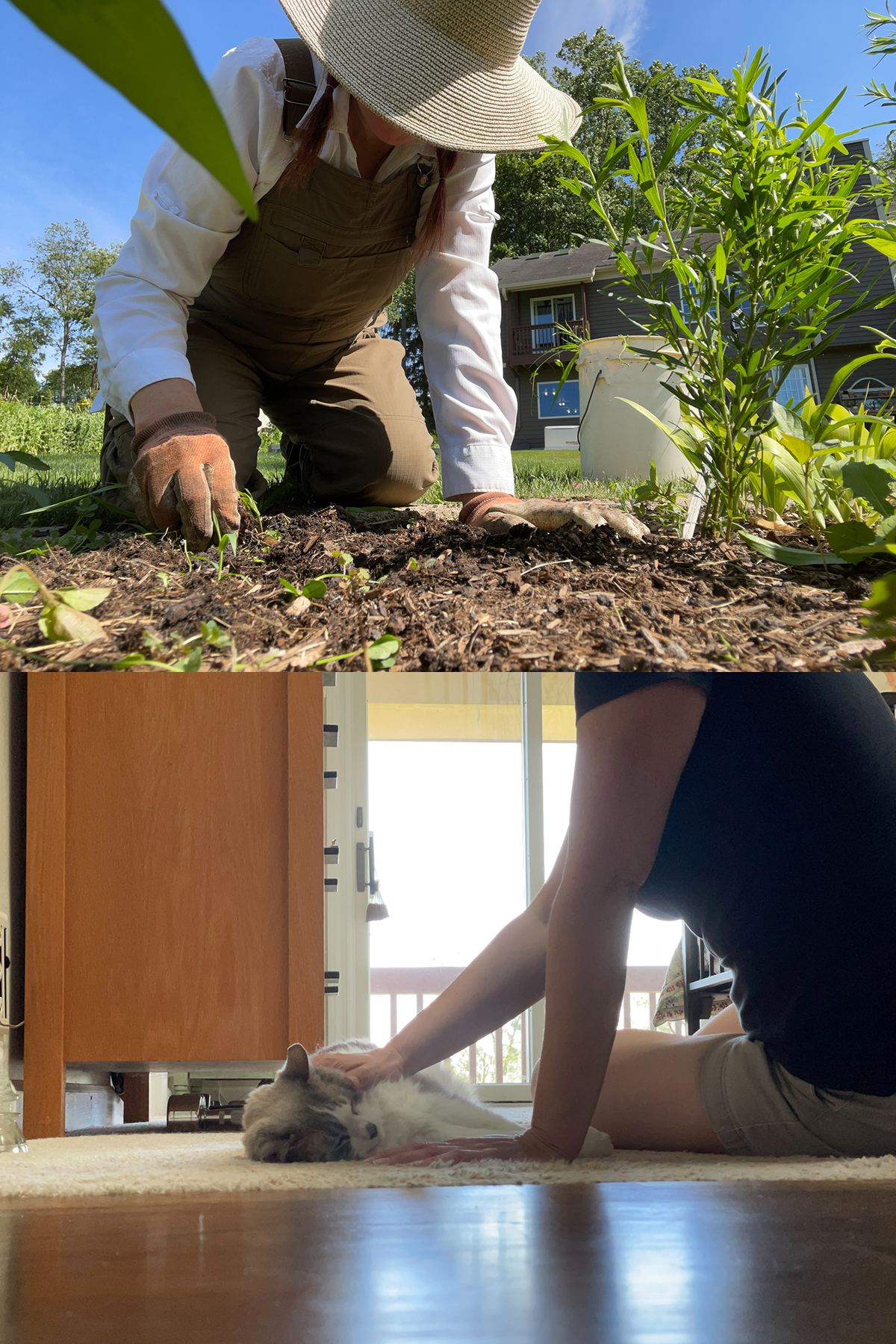
05 – Portrait
Don’t forget about portrait mode and lean in a little.
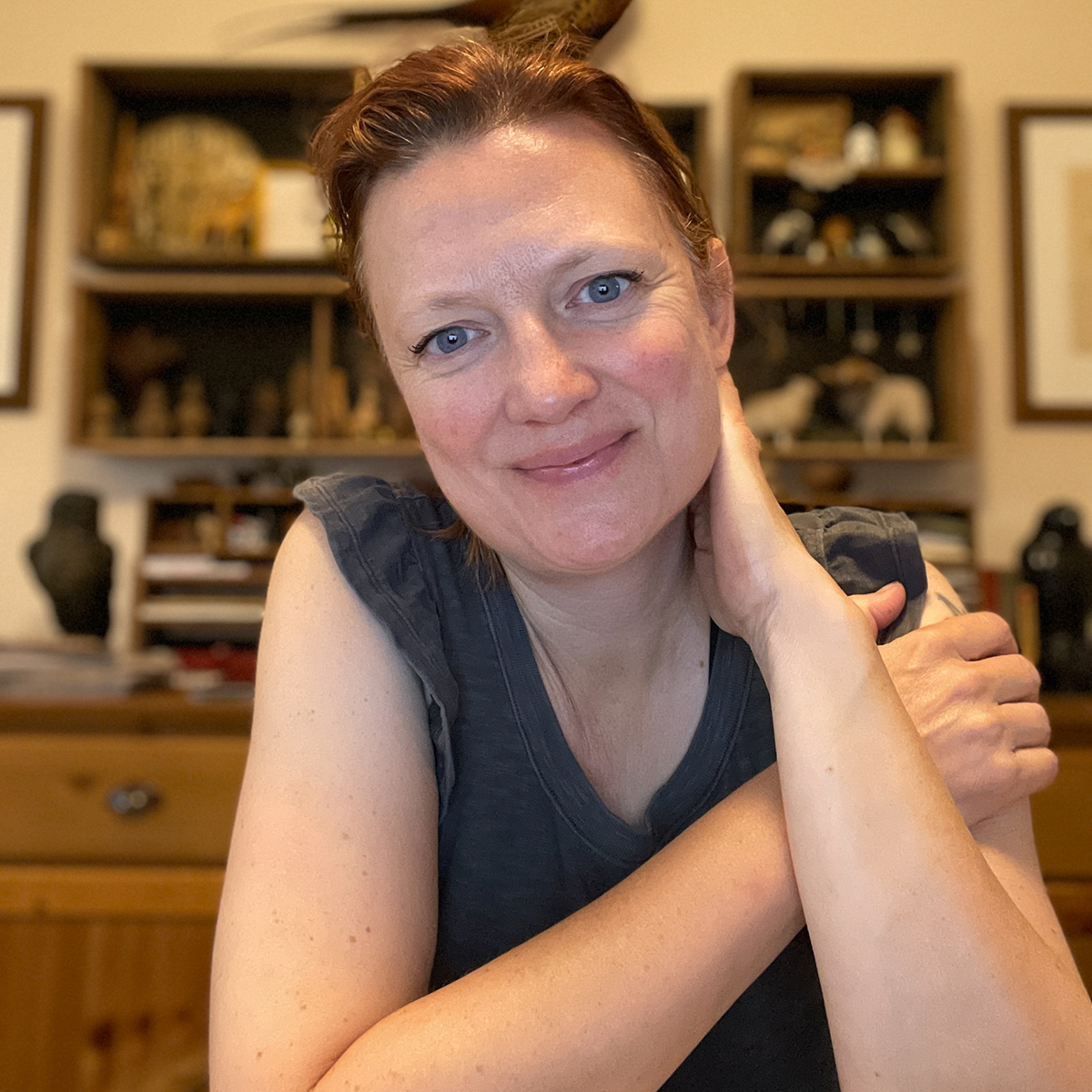
06 – Different angle
Try a different angle. Top down, from the side. It’s hard to get a photo of us all on the couch. I could have used the timer, but I would have ruined the moment. A top-down photo works to capture the moment without disrupting it. I wanted to get a photo of the first time I was using our new rain barrel. There wasn’t a good place to set my phone, so I just held it out a took a shot. It works to tell the story.
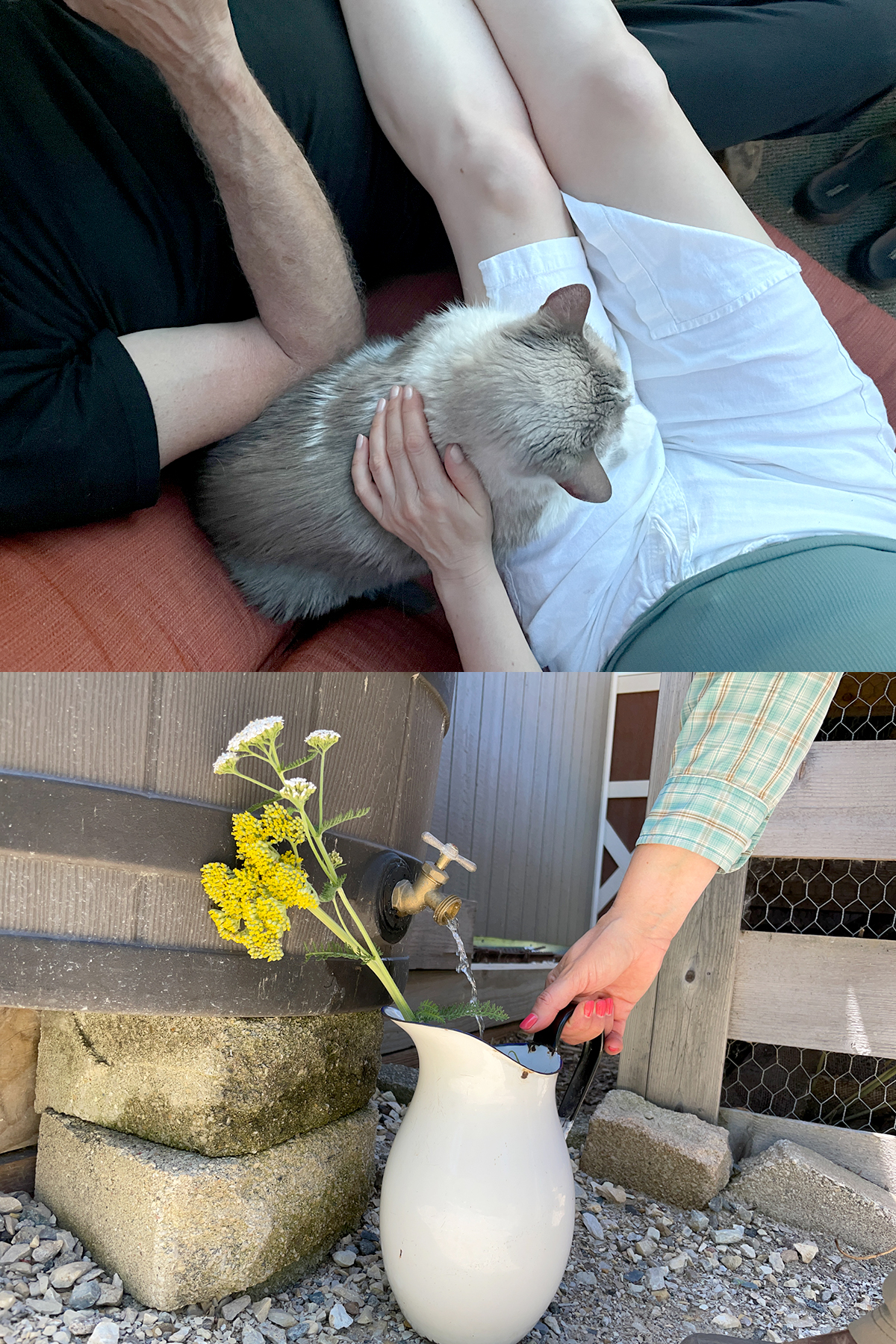
Links Mentioned
- 49 and Market Curator’s Meadow
- Heidi Swapp Stop the Blur
- printer’s tray in Emily’s room
- Simple Scrapper membership
[00:00:00] Jennifer Wilson:Welcome to Scrapbook Your Way, the show that explores the breadth of ways to be a memory keeper today. I’m your host, Jennifer Wilson, owner of Simple Scrapper and author of The New Rules of Scrapbooking.
This is episode 183. In this episode I'm joined by team member Helen DeRam to chat about seeing the details of your life, including yourself, in your photos and your scrapbooks. Our conversation runs the gamut from the practical to the personal. Plus, Helen also offers specific tips with examples in the show notes. You can find this episode and 182 more at simplescrapper.com/podcast!
[00:01:04] Jennifer Wilson: Hey, Helen. Welcome back to Scrapbook Your Way.
[00:01:06] Helen DeRam: Hi, Jennifer. I'm happy to be here.
[00:01:10] Jennifer Wilson: Yes. And I am correct. That you've been on before, right? Yes.
[00:01:14] Helen DeRam: Yes, I have.
[00:01:14] Jennifer Wilson: We did talk before. Okay. Sometimes my brain, uh, fails me the older I get. Can you share a little bit about yourself with our audience to refresh their memories?
[00:01:27] Helen DeRam: Sure. So I live in Illinois with my husband, Rudy and our senior cat, she's 17 now. She's a little bit of a hot mess right now. I don't have any kids of my own, but I have a stepson, Kyle he's in his thirties. I am a Director of IT. I've worked at the same company for 20 years. I've also scrapbooked 20 plus years. And when I'm not scrapbooking, I like to do gardening and go antiquing.
[00:01:56] Jennifer Wilson: Mm. Sounds So fun. Yeah. I love all of your gardening photos. I'm someday I will have more of a green thumb now it's only my husband keeping things alive.
[00:02:06] Helen DeRam: Well at least there's one of you.
[00:02:09] Jennifer Wilson: So what's it. Yes. Yes. Yes. For a long time, there was neither of us. And then he, the pandemic turned into him, turned him into a plant daddy. And so he's all into it now. Yeah. Yeah. It's really nice to have plants in the house. Cause we didn't have any pre pandemic. And then he brought in a bunch that he had in his office and then we just kept adding and now we have like a plant room.
[00:02:32] Helen DeRam: Oh, that's great.
[00:02:33] Jennifer Wilson: It's awesome. So what's exciting you right now in scrapbooking and memory keeping?
[00:02:40] Helen DeRam: So I'm really just loving the brand 49 and Market and everything they're putting out. And I, that might have been my pick last time as well. Particularly the rub ons that they have. I think I have all of them and I have some more on my list. There's a new collection, coming out called, or it's out now, it's in my, one of my carts, Curator's Meadow. It's, you know, it's all natural stuff and there's some animals and butterflies and flowers and things. And I just love that. And the rub ons, particularly, they're just beautiful and they work really well. You know, rub ons back in the day were not so great. These are just beautiful. I try and put them on all my pages.
[00:03:25] Jennifer Wilson: Yes, I can ima. I can see how that fits with your style and yeah, their products are really beautiful and of course, rub ons are one of the most fun supplies ever. So.
[00:03:36] Helen DeRam: Yeah, they're great. And they, like one of the ones that they have, or a style that they have are like little splattery dots, which I love because I can just rub them on the page wherever I want. Not have to worry about actual ink or paint or anything.
[00:03:52] Jennifer Wilson: Yes. Yes. I I've heard that several different conversations we've had on the podcast about ways to get the messy look without the mess and with rub ons, you know, doing a hybrid type of thing, and I'm on their website now, and I'm gonna have to buy some of these rub ons myself Cuz I'm, I'm a big fan. I love the variety they have. Like the painty things and the botanicals, like it's.
[00:04:19] Helen DeRam: Right. I know. And yeah, the, the latest one, that Curator's Meadow, they have like animals and then they have like those like tea stain or coffee stain from your cup, like in the same package. So you get just a really nice variety and some words and things too. So yeah, I'm kind of addicted.
[00:04:37] Jennifer Wilson: Very cool. Yes. We will include a link in the show notes to these for sure, because they're, they're quite lovely. So Helen what's on your memory, keeping bucket list? This is a story that you really want to tell, but for some reason you haven't gotten there yet.
[00:04:53] Helen DeRam: Yeah. So this has been on my list for a while. It's about my dad. So my dad was born in Hungary. and then, in 1956 there was a revolution and he was a young 18 year old man. And his dad was like, you need to get out of the country. So we had some relatives in the US. So basically he's 18 years old by himself, you know, leaving on a ship to come to America and the, he tells a story and the only thing he brought with him was a roll of film in his pocket. And, so we have the, yeah. isn't that just, it's just, I don't know, it's amazing. I just love that. That was the only thing he wanted to bring, that it was that important him. And so those photos are photos of him kayaking the Danube river and the, the photos are kind of a little blurry and kind of scratchy. I don't know if that's just because he carried it in his pocket. Um, so I want to, you know, document that story and those photos. Cause I just, I love that story and I think it's, it'd be really.
[00:05:59] Jennifer Wilson: That amazing.
[00:06:01] Helen DeRam: Yeah.
[00:06:02] Jennifer Wilson: There's yeah. Just like there's so many layers to that. And you could bring in other photos of his, Yeah. that just sounds so beautiful. So what a great bucket list story.
[00:06:14] Helen DeRam: Yeah, thanks.
[00:06:15] Jennifer Wilson: I wanted to talk to you today about photography and, you know, let's catch up a bit first. You were on episode 130 talking about projects. So I'm curious, kind of what projects are you working on right now? So we can give our audience a little more context before we dive into more of the photo topics.
[00:06:35] Helen DeRam: Sure. Well, I always have lots of projects on my list. My scrapbooking is very open ended. This year I decided to do a memory planner, kind of Heidi Swapp style, the Stop, The Blur, and I'm really enjoying that. Um, with summer being a little bit busy, you know, I'm feeling a little behind on that, but that's definitely one of my projects. And then working on 2020 and 2021, I like doing the summary style pages that the creative team, that we've we've been doing for the Spark Magazine. So kind of summarizing a season or a trip. So I think I'm gonna do more of that for some of the years that I'm trying to catch up on. And then, this week is Ali Edwards Week In the Life documenting. So I am doing that. And, I will be doing a 10 by eight album for a Week In The Life this year. I've done that for many years and I wanted to continue that one. I was kind of on the fence. Like, do I want to do I wanna do it, but I just really do love that project and you know, wanted to make sure I did it again this year.
[00:07:46] Jennifer Wilson: So what led you to choose the 10 by eight size?
[00:07:49] Helen DeRam: Uh, I just wanted to do something different. So I purchased a 10 by eight album whenever she first had it. And I'm using it as a home album to document different, parts of my home. And it's, it's a really different size and so it's just really different creatively. Um, so, yeah, I just wanted to try something different. I, I've done a six by eight Week In The Life since, for all the years I've done it. So I'm a little upset that it's gonna fit differently on the shelf, but , it was worth it just to try something different.
[00:08:28] Jennifer Wilson: I would have to say that that sometimes influences my decision. So. So we are now in the Photos Creative Journey. This is our two month kind of learning period. It's, uh, taking place in July and August. And I really wanted to talk about developing confidence as just an everyday photographer. So just an amateur photographer who takes photos of their family, of their life of themselves, because they like to keep their memories. So maybe you can tell us a little bit of your history. What sparked your interest in taking photos at all?
[00:09:09] Helen DeRam: So I was thinking about this and I really grew up with, photos and taking pictures,being a regular part of our lives. My mother loved taking photos. She, you know, she always wanted take pictures of us doing stuff. And she always wanted to be in the photos. When I was kind of like that preteen age, she got me one of those Disc cameras, which was like, the role of film was actually like this flat disc. And it went in this little flat camera. And so, you know, she let me take pictures of whatever. You know, my friends and I would do like a fashion show and we would take photos of each other or me and my sisters or whatever we were doing, you know. So she let me kind of take pictures of whatever I wanted. And then it was always, you know, exciting to get those developed and put them in albums. It was really a big part of our everyday lives. You know, photos and getting pictures developed and putting them in albums and looking back at them and, and talking about them. And, so I think it was just part of my growing up.
[00:10:20] Jennifer Wilson: Yes. Yeah. That's, that sounds So familiar as well. And it's not, you know, it's not something that I've ever thought of before. And I think that's a, that's a bucket list story for me to talk about how I came to memory keeping, came to scrapbooking from this a legacy, a lifetime legacy of always having photos in my life. From, you know, we had Polaroid camera and you had to, know, you only had five flashes and you gotta make sure you use them well. And,
[00:10:49] Helen DeRam: Yes.
[00:10:50] Jennifer Wilson: Yeah, so definitely thinking about that, that would be some, some really fun stories to tell.
[00:10:55] Helen DeRam: Yeah, definitely.
[00:10:56] Jennifer Wilson: So have you, have you taken any classes or participated in any projects to intentionally improve your skills or have you just kind of picked it all up on the fly?
[00:11:07] Helen DeRam: Um, I sort of just picked it up and maybe a little bit through osmosis from Rudy, my husband, since he's a fine art photographer, you know, I think part of when you're doing something is you're explaining it, you know? So he would talk to me about different aspects of, the photo, and he's not so much into the technical parts, which I don't really know how to do, but more about, you know, composition and maybe capturing a story in your photo. So I think maybe just through osmosis, , I've picked up tips over the years.
[00:11:46] Jennifer Wilson: Okay. so I did not, know, this about your husband. So this kind of this shifts things a little bit, I'm curious, like, so the photos that you share And that you use on your layouts, how many are you taking versus how many that he's taking?
[00:12:01] Helen DeRam: Most of them are mine. Yeah. They're you know? Yeah. I use my, my camera or my phone, on, you know, my camera phone. So when we would, years ago, not years ago, but for many years we would take long road trips out west. And when we did that, part of that trip was for him to take photos of, you know, Western type things. And so any of those photos that I would use in my travel albums, you know, I would use some of the ones that he took, but really our vacation part of it was still photos that I took. And certainly the ones I use on my pages and that I post are ones that I take.
Sure. No, this is just So fascinating in terms of how, you know we always talk about like, surrounding yourself with people that inspire you and, you know, help you learn new things. And so that's definitely an example of, you know, having someone in your daily life that, that can nudge you in a certain direction. And, you know, as you said, learning by osmosis. So that's really cool.
Yeah.
[00:13:11] Jennifer Wilson: So some of my favorite photos of, yours are these little still life scenes, little slices of real life, from like, washing dishes or a, you know, a cabinet that you know, looked particularly cute. What is typically your objective or purpose behind these shots? Like what are you thinking about in the moment?
[00:13:31] Helen DeRam: So I like kind of capturing, the stuff of life, right. I like seeing, um, You know, I, so in my house, I like to change my decor a lot, just kind of move things around. And so I like taking photos of that. I like just kind of seeing and looking back and seeing how things are. Like I remember,when I was a teenager, my dresser, I had all these little, you know, knick knacky things on my dresser and then the mirror, I had all these photos and, you know, kind of tucked in the side and postcards and little things. And one of my friends took a picture of my dresser and gave it to me and said, here, put this picture of your dresser on your dresser, mirror. But looking back at that photo, like. I just love it. I love seeing all the stuff I had and it brings me back to that time and that feeling. And so I wanna make sure that I'm still capturing those types of things now. Whether it's, you know, what's on the table or what's, on my bookshelf or, in a corner. And then I also like to capture, you know what I'm doing. You know, whether it's something like doing the dishes or doing something I love, like gardening or scrapbooking or, you know, just the doing the things that, that I like to do.
[00:14:59] Jennifer Wilson: Yeah. I love, I love those little shots of especially ones I see from the past where obviously it was a photo of a person, but then you noticed the stuff in the background. So intentionally taking kind of those contact shots are really fun. And I'm, I'm thinking about this little display in my daughter's room. I have one of those, Printer trays, right? For the, all the letters and stuff. And I'm, I'm guessing you have at least one of those, cuz it seems like your style. And, but I did mine all with like I painted it white and it's got little scrapbooker paper backing each little box, different paper for each one. And it was all very like kind of cutsey cause it was for her, for her nursery. But now she's taken all of her little, little animal toys that you don't really know where to keep. She has them all like set up in there because it's the perfect little home for them. And so I need to capture that before that goes away before she's no longer interested in that. And she's decided she doesn't want those little things. So.
[00:15:56] Helen DeRam: Definitely. yeah.
[00:15:59] Jennifer Wilson: So when you are taking these images, are you kind of styling them or do you just jump in and capture it right as is?
[00:16:08] Helen DeRam: So. It's just as is. I find if I try to style it, it doesn't look right. Like, and I was thinking about it as like, when you're styling something, you're trying to make it look like real life. And so for me, you know, just taking a photo of real life is easier and, and turns out better. So usually, you know, I'll just take, I'll take a shot and I'll look at it real quick. And if something that I wanted to be in the picture is not, or if it's, totally wonky and crooked, then I'll, you know, try and take another photo and then, and then just kind of go with it. You know, cuz it's the real life part, that I'm trying to capture.
[00:16:52] Jennifer Wilson: Mm, I love that perspective, you know, especially as you mentioned right now, we're in Week In The Life. And just having that permission, to accept imperfection, to expect, accept life as it is. I think is really, you know, empowering when you're not always feeling as confident in your, in your photo taking. So.
[00:17:14] Helen DeRam: Yes, definitely. And I always try to think about my future self looking back, you know, I'm not gonna worry so much if something wasn't perfectly positioned in the photo, I'm just gonna like to be able to look back at it. See what was important at the time.
[00:17:30] Jennifer Wilson: For sure. Do you have any like particular, like tips or techniques that really stand out to you as, as things you kind of rely on or go back to?
So if it's, you know, if I'm trying to take a photo like a, of let's say my table, like a flat, you know, what's on the table. I just try to hold the camera where my phone is square and flat as possible. And like, you know, take a quick photo, check it, is there, you know, something I wanna change, maybe if someone is there, ask them to just like put their hand in the photo because, I find sometimes that, you know, I did that, that happened once accidentally and it was, it looked, amazing. It looked really great, you know, like just grab your cup of tea or whatever. And then something that, you know, people probably already know by now and are doing, but make sure your lens is clean. If you're using your
[00:18:27] Jennifer Wilson: Mm.
[00:18:28] Helen DeRam: Camera phone. Especially if you're using that front lens, um, you know, I'm always checking it before I take a photo to make sure that it's clean. So, and the other thing too, is. um, I'm trying to capture a lot of times, you know, we'll be doing something and like, it's just a great moment or feeling or whatever. And I wanna try and capture that feeling. So if you're just kind of feeling the moment, like it doesn't, it doesn't even have to necessarily be a picture of you or the people, but maybe just part of where you are and trying to capture that feeling. Um, I think that, that kind of helps like, if you're you're in the moment, you're feeling that feeling, take that photo. And usually that photo then, you know, is kind of a nice reminder back to that moment.
[00:19:22] Jennifer Wilson: Yes, Yes. I. think I've given myself permission to take truly, sometimes horrible photos, just to be able to like capture a moment because I know I don't have time here to like, get the settings right or change anything about it. All I can do is choose to take the photo or not take the photo. And I've only regretted not taking the photo. I've never regretted taking a photo. So.
[00:19:45] Helen DeRam: Right, right. Absolutely.
[00:19:48] Jennifer Wilson: Yeah. I, I will always think back to the day we brought my daughter home and we didn't take any photos. We took photos at the hospital before we course we, there. were lots of photos taken later. But that day I wanted a photo of like the three of us on the front porch and we did, we never got one and I kept thinking, oh, we need to do that. And then, you know, something was getting in the way or yeah. So always take the photo.
[00:20:13] Helen DeRam: Yes, absolutely.
I've also noticed that you are very skilled and clever at incorporating more of these other shots, these contact shots, the landscapes, the everyday life shots into your scrapbooking. It's not just people photos. So when you're putting together a layout, particularly these, you know, you do a lot of like really beautiful, detailed 12 by 12 double pages. How do you decide what you wanna include?
[00:20:44] Helen DeRam: I always try to, include, like, I want pictures of the, people, whether it's, you know, whoever was there, like all together or at least separately. And then I want I definitely, you know, if there's landscape, I wanna include that. And then, you know, if it's like an everyday kind of thing, like home life, I wanna make sure there's a picture of the cat in there somewhere. Um, and then, you know, a part of, you know, the stuff. So it's kind of like my little do I have everything, represented, you know, I have me, I have Rudy, cat whoever else was there. You know, if Kyle was there, and the scene and what we were doing, I, I try to include all of it and some closeups, some far aways. I, so I do kind of, um, look at that intentionally when I'm putting my pages together.
[00:21:36] Jennifer Wilson: I love that. I think, I know I need to do more of that. I'm just, I'm very like feeling very like self reflective during our conversation today. So, um, I will sometimes just end up choosing one photo because it's the best one, rather than choosing more photos that can provide more context. And so, Yeah, I think I, I will definitely include at least one example of your pages in the show notes for this episode, so that our listeners can see kind of the, the variety of types of photos that you'll include in a page. Now shifting gears. I also noticed, and this is really kind of what prompted me to ask you on. Is that you've really focused on taking regular selfies over the past year. And you've been participating in, the Thursday three project. This was a hashtag on Instagram where you're invited to share, three things about yourself. And this was started by Kristen Tweedale, and can you maybe start by telling us why you decided to, to share, through that project?
[00:22:41] Helen DeRam: Sure. So I wanted to, be posting more on Instagram of the, you know, my what I'm doing with my scrapbooking, my layouts and, memory planner and stuff like that. But I didn't want it to just be that. I wanted to incorporate, you know, a little bit about me. And I was hoping that, you know, since it's, you could do it weekly, obviously. That it would encourage me to post more regularly. Cause a lot of times I'll think like, oh, this would be great to post on Instagram. And I'll even like in my head, figure out what I'm gonna say, but if I can't do it at the moment, that moment passes and then I'm like, it comes around later. I'm like, oh, I'll just, you know, I won't post it. So I was kind of wanting to do Thursday three to encourage me to post more and to share a little bit about myself, so it's not just my scrapbook pages. So that's why.
[00:23:34] Jennifer Wilson: Oh, I love that. And I hear that so much on the podcast on how varying degrees of accountability, you know, even this one is, is kind of the, the lightest level of accountability you can get, but that helps us do more of the things we want to do. And because we're, you know, when you have others out there who are going to react to it, that provides a little bit of positive feedback, and I think it's kind of. Self, uh, self nourishing in a way. That it, the more you do it, the easier it gets and the more you, you know, even look forward to doing it. So I think it's a really powerful activity and I love, I love sharing as much as I can through it as well. So I'm curious. Are you a one shot, here's my selfie. I'm gonna then, you know, share this one or how many images do you typically take before you pick the one that you're gonna post?
Rarely is it one shot. So I look back at my last, Thursday, three post and, found all the photos and there's actually like 16 photos. Which sounds a little ridiculous. But. What I do is, I, just take them all really fast. And a lot of times I'm not necessarily even looking at the camera, I'm just, you know. I'll hold the camera up, take a photo, you know, change my expression or turn my head or do whatever and just keep taking photos. And some of them are, you know, even just blurry in between photos. But I find that, you know, if I take more photos, I'm more apt to get least one that I like. So, um, So that definitely, I, I tend to take more than just, you know, one and done. I usually take a bunch before I even look at them too. So rather than taking one and looking, you know, just take a bunch and then just kind of look through them all.
[00:25:33] Jennifer Wilson: And I think there's something really important to that because I know, that I've, well, sometimes when I do that, I will say, oh, that one's no good. And I delete it. And then I keep going and like, oh, but maybe that one I deleted was better. And I think it's good to just to take a whole bunch and then kind of start weed, narrowing them down from here's the batch. I'm gonna pick one and then move on with my life rather than. Take one, look at it. Not like it keep taking another one and eventually it's like the first one that ends up looking the best. Right. So.
[00:26:07] Helen DeRam: Right.
[00:26:08] Jennifer Wilson: I think that's sometimes one of the most natural is the first one. Uh, so yeah, it's, it's interesting, but I, I think one of the messages here is that for every lovely selfie you see on Instagram, somebody probably took. Multiple shots, if not many in order to get one that you know was flattering and that they're proud of. And so if your first selfie isn't coming out awesome, that's pretty normal. Like it's normal to, uh, that you weren't looking the right way or, you know, it was a weird angle that wasn't quite as flattering. So I think that's, it's pretty typical to do that.
[00:26:44] Helen DeRam: Yes, definitely.
[00:26:47] Jennifer Wilson: So have you always been comfortable taking selfies or including yourself in the photos?
Yes, I, I have, I don't know. You know, when we officially started taking selfies, I was trying to think like with my little Disc camera if I was taking selfies. I think maybe me and my friends were just taking pictures of each other. But my mom, you know, again, back to my mom. She was always taking photos and she always wanted to be in the photo. It wasn't, It wasn't, uh, you know, she wanted, she wanted to be in the photo. She's like, you know, take a photo of me with, you know, Nancy, Jenny, my sisters, or take a photo of all of us. She wanted to be included in it. So, I think just kind of growing up that way, it was, it was normal to be in the photo to take photos of yourself. As a matter of fact, like, um, my mom passed away about five years ago, but, you know, I had all her photos and her camera and, you know, she was taking selfies of herself in, you know, in her seventies. And I just thought that that was awesome. So.
[00:27:51] Jennifer Wilson: That is awesome. I love it. So, so how does it feel when, when you take a photo of yourself, like what's, what's your kind of internal monologue as you're reviewing those, you know, the 16 options to pick the one to share?
Well, usually, you know, the, the, the time or the day or whatever, I'm gonna take a selfie it's because I'm feeling good. You know, whether
[00:28:14] Jennifer Wilson: Mm-hmm
[00:28:14] Helen DeRam: Feeling like, oh, my hair is nice today. Or I like my cute shirt or I I'm just happy. And I wanna capture this happy feeling. So usually it makes me feel good. And I'm taking a photo because I feel good. You know, there's maybe like an odd photo or two, especially from like pandemic era where I wanted to capture my not feeling good days. But, but normally, you know, I'm, I'm wanting to capture a happy feeling and so, you know, I'm feeling good about it. I do, you know, we all kind of can be harsh judges of ourselves and, I try not to do that and just say, well, that's an unflattering photo. I'm not gonna use that. No one needs to see it. , You know, and just kind of go with the one where I, I like the way it looks. So, um, yeah, I try not to let myself feel bad about what the camera did. I guess.
[00:29:18] Jennifer Wilson: Yes. Yes. I love that well you're like, kind of itemizing the scenarios in which you feel good and sometimes, to me. It's like, oh, that's really good light. So whether it's me as taking a selfie or taking a photo with my family, I'm like oh, that's really good light. Let's go take a picture. That's will kind of trigger me into getting excited because I know, it's more likely to turn out well, if the light is good.
[00:29:41] Helen DeRam: Yes, definitely. Light is very important. We're always, yeah. We're always looking for that. When we're taking family photos, like we were just doing that this past weekend, you know, like with my dad for father's day. Like no, over here, let's walk over here now and it's better over here. So.
[00:30:01] Jennifer Wilson: So one thing I noticed, and you've mentioned this a little bit, that you definitely vary the perspective, kind of the approach to your self portrait. Some of them, uh, look like you took, you know, extending your arm out. Sometimes used maybe a self timer, remote shutter. So is kind of this variance. Is this an intentional creative decision versus just taking the same kind of selfie like every week?
Yeah, I want to make sure, and I think I said it before, I want to capture the things that I'm doing and especially the things that I really like doing. And again, capturing that feeling, you know, like, It's let's say it's a, you know, a rainy Saturday and I have nothing to do and I get to scrapbook all day and I have a fresh cup of coffee and just everything is perfect. And, you know, I wanna capture that feeling in that moment and, and me scrapbooking. So when I look back on it, I remember that um, so. I, yeah, I like capturing me doing the things I like doing. I, and I also like doing the, you know, just the standing in front of the mirror kind of selfie. So I do, I do definitely like to vary it up and capture, not only, you know what I looked like on the day, but what was I doing? Doing something I love.
[00:31:18] Jennifer Wilson: And are there any like particular kind of technical strategies that you use to make taking those photos a little easier, whether it's, you know, having a remote shutter for your phone or you use a specific app, is there anything that you do to, to take these photos?
[00:31:36] Helen DeRam: So I'm really just basic. I don't even have a remote shutter.
[00:31:41] Jennifer Wilson: I don't either. I don't even have an Apple watch, so
[00:31:43] Helen DeRam: I don't. Yeah.
[00:31:44] Jennifer Wilson: It's okay.
[00:31:44] Helen DeRam: Don't either. Um, yeah, so it's literally just, you know, holding the, holding the phone out. I do use the timer for sure. And then, you know, if it's me doing something or me and Rudy doing something, whatever, um, I'll prop it up somewhere, you know, on a, you know, on a book, on a rock, on a bucket, whatever. I can, um, and just kind of figure out like, well, if I have to prop it up on a rock, it's gonna be a low angle and this is what it's gonna look like. And that's, you know, that's. It's gonna be a different shot because of that. And I'm, I'm okay to go with that. Like, it doesn't have to be always from the same angle. So I like varying it up that way. And sometimes, and I used to do this all the time. I never used the front selfie camera originally because that wasn't, you know, for a long time, that lens wasn't really good. And, um, so I would, you know, use the back one and I'm holding it up, taking a selfie and my friends would make fun of me. Like, what are you doing? You can't even see yourself. I'm like, yeah. But I like the way this looks better, ultimately, you know, I might not be able to see myself, but I'm gonna get a better picture. So sometimes I'll still do that. You know, you get kind of a different look, a wider angle. So, um, so those are really.
[00:33:06] Jennifer Wilson: Think it looks better for, I think now that the, the front camera is a better lens, it's almost too good. I'm like, this is showing like every on my, face. Whereas the rear lens is doing something to zhuzh it up a bit. I don't know, but I I just took one right before we got on and I took one both ways front facing and rear facing. And the rear facing was by far a better photo. So uh, you know, I wasn't perfectly centered, but who cares? I'm gonna crop it anyway.
[00:33:36] Helen DeRam: Right, right. Well, good. I'm glad I'm not the only one doing that.
[00:33:40] Jennifer Wilson: No, definitely not. So do you have any advice for someone who maybe is lacking in confidence of, of taking photos in general or taking photos of themselves and, you know, you want 'em to, to kind of feel what you feel without having the same kind of, you know, lifelong tradition of, of getting in the photo.
[00:34:04] Helen DeRam: So I would say start where you feel comfortable. So if you're most comfortable in your house, maybe nobody's around or lock yourself in the bathroom. . And just take a bunch of photos, you know, don't, like we said before, don't take a photo and look at it. Just take a bunch of photos and know that you can delete all of them if you don't like them. And you don't have to, no one else has to see them. You don't have to share them necessarily. Just get in there and start taking photos. I guarantee if you take, you know, if you take a multitude of photos, there's gonna be at least one that you like. And then for that one that you like figure out, you know, why you like it? Is it the lighting? Is it the way you held the camera? Is it the way that you're posing? And then remember that for next time. Or try to recreate that in a way, So I think, you know, just go where you feel comfortable first and then, and then start trying to see what you can capture.
[00:35:06] Jennifer Wilson: I think that the experimentation definitely helps even like height of the camera. Whenever my husband's taking a photo of me, he always has it like really low. And I'm like, no, you need to go a little higher. It tends to be, you know, a more flattering perspective. You can go a little higher rather than like taking it knees up or something. So um, Yeah, like, but just, but experimenting, even having the really bad shots helps you understand what makes a good one versus a less good one for sure.
[00:35:35] Helen DeRam: Yes, definitely. Yeah. Change where you're holding the camera and definitely try the timer. You know, you don't need any fancy equipment, just prop it up on something and you know, run over to where you wanna be. And obviously having a remote, would help and then you can just take a bunch of photos at once, but just experiment and play and have fun.
[00:36:00] Jennifer Wilson: Well and I think using the timer, I've gotten some really interesting shots, like maybe where It focused on the background or the extreme foreground versus the subject. And some of those are just end up being really beautiful shots that can create like white space to add journaling when it ha when that happens sometimes. And yeah, I like the, the surprise of it. And you get some, some really interesting photos when you take a lot of them.
[00:36:26] Helen DeRam: Yes. definitely. Yeah. Finding that happy accident, it's always good. And then you probably won't be able to recreate it. But it's, um, it's, it's nice to have that one.
[00:36:39] Jennifer Wilson: Yes. Yes. So Helen, this has been such a lovely chat. Can you share where our listeners can find you online? Anything maybe that you have planned for the rest of this year?
[00:36:51] Helen DeRam: So online, I'm really just on Instagram and I'm hderam and I post my layouts there and, my Thursday threes. And I'm always trying to post more. I feel like, things have gotten busy and I, I haven't been posting as much, but, um, I'm mainly there and then Simple Scrapper members can, see my pages or my layouts in the Spark Magazine that comes out. So those are really the main places you can find me.
[00:37:24] Jennifer Wilson: Yes. And by this time when this episode goes up, we will have our July, August issue up. And it is definitely going to be a good one. Helen, thank you for your time.
[00:37:33] Helen DeRam: Thanks for having me, Jennifer. It was a pleasure.
[00:37:37] Jennifer Wilson: And to all of our listeners. Please remember that you have permission to scrapbook your way.
Sign up to receive email updates
Enter your name and email address below and I'll send you periodic updates about the podcast.
How to Subscribe
The best way to listen to Scrapbook Your Way is with a podcast player on your mobile device or with iTunes on your computer. You can subscribe via Apple Podcasts, Google Podcasts, or by searching for “Scrapbook Your Way” in your favorite podcast player in order to receive new episodes automatically.
If you’re enjoying the podcast, we’d love if you left a review on iTunes.
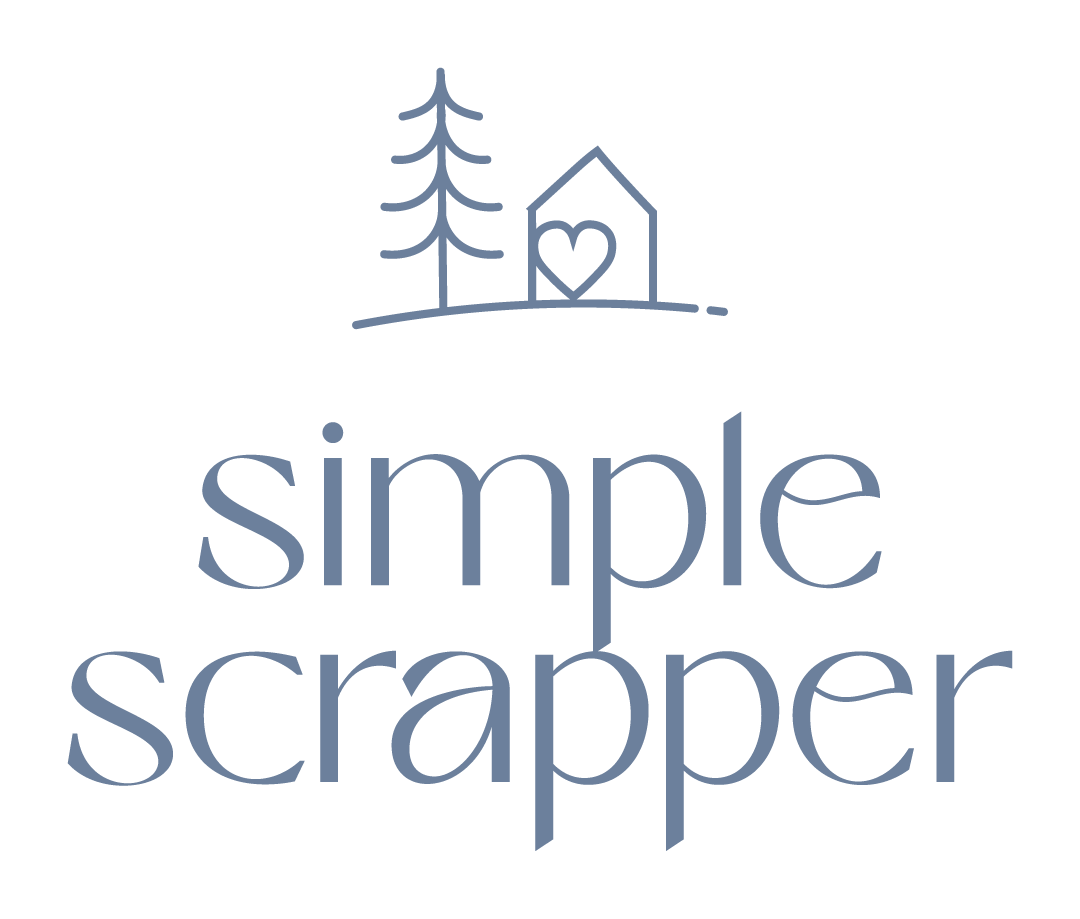
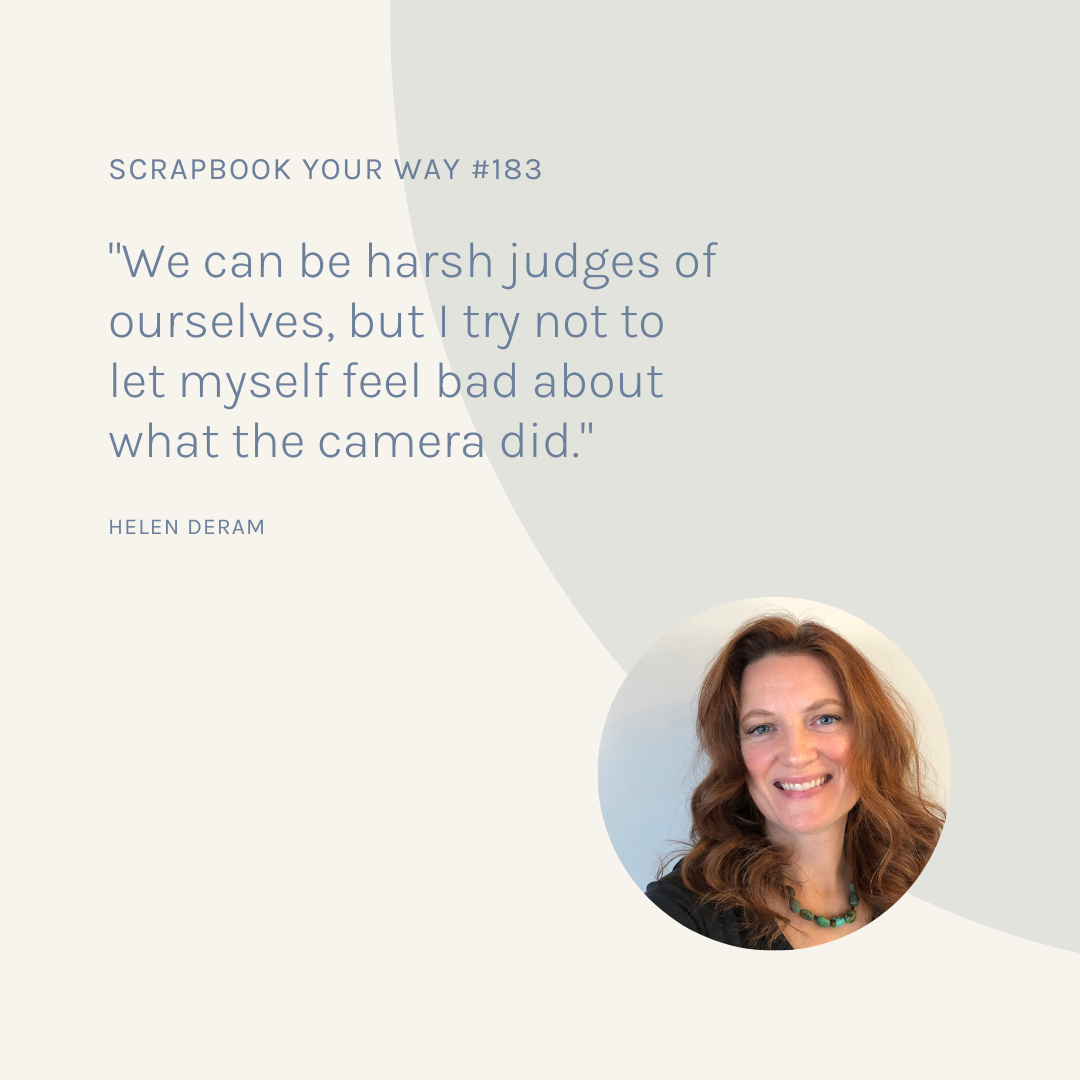
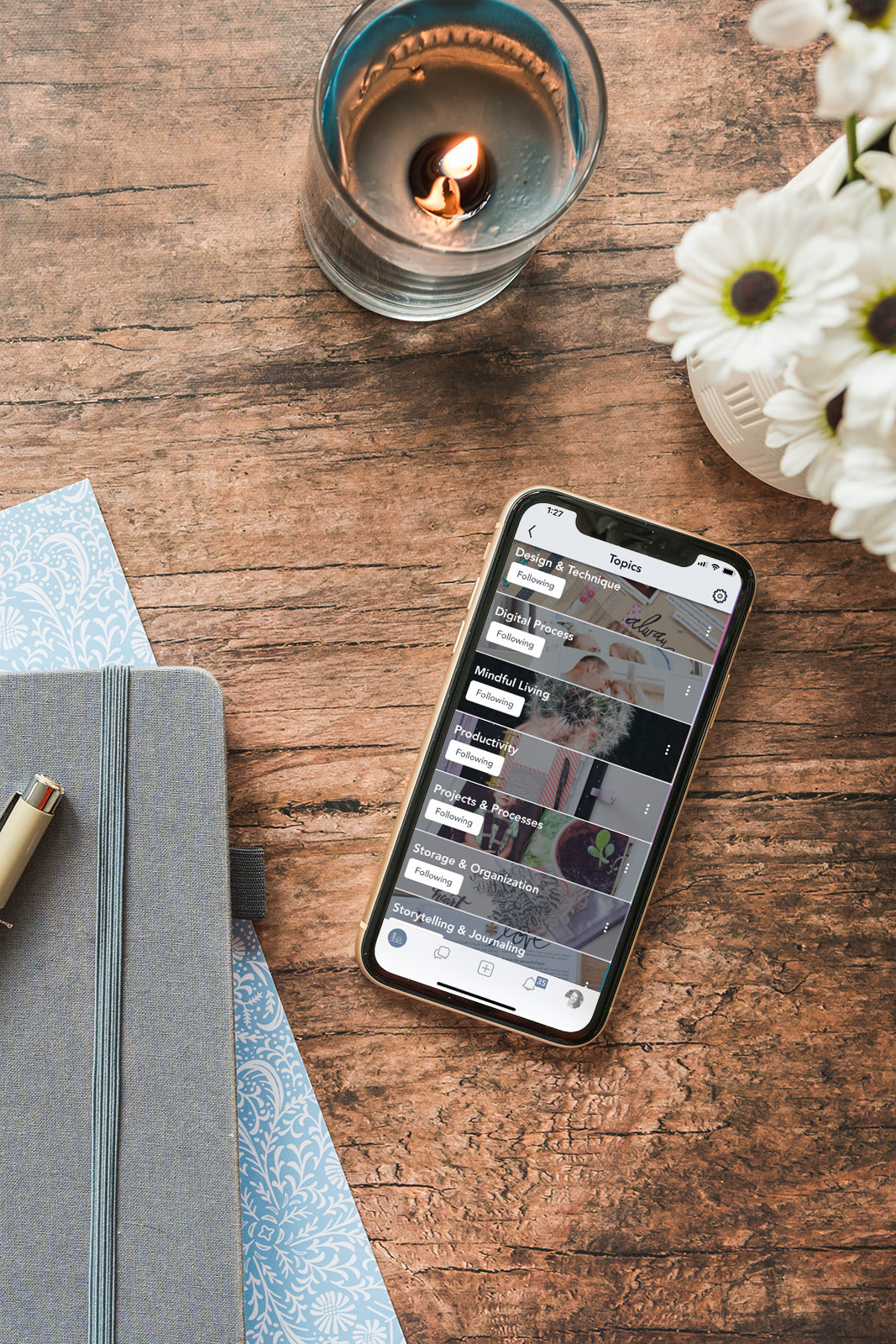
0 Comments